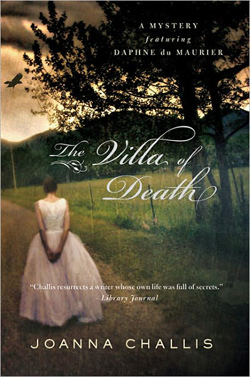
“Last night I dreamt I went to Thornleigh again.” Thornleigh? Villa of Death by Joanna Challis is the third in a series featuring Daphne du Maurier, amateur sleuth and budding author who spends so much time in her own head working through the permutations of her most famous novel that deadly dealings serve only as way stations on her road to another adjective.
It is the summer of 1927, and Daphne is headed to Thornleigh for the wedding of a friend. The friend’s husband is poisoned after the ceremony; there is a second murder and a kidnapping. Suspects and red herrings abound. Daphne even gets engaged to the dashing Major Browning. But it’s not enough to keep a reader engaged.
Even fans of Rebecca will tire of the many fictionalized false starts to her novel. We know that Thornleigh will become Manderley and we can feel a little superior for knowing it; however, the cost is reading descriptions that bring to mind not so much Manderley as a beginner’s writing class.
Beyond the trees, Thornleigh stood ancient and proud. Light rain drizzled down the crenulated turrets and the huge Jacobean wing with its endless mullioned windows and pretty gables. Red and green ivy flourished up the three turrets surviving from the original castle and, I was happy to note, had begun creeping across the lime-stone mansion.
Despite her false starts, Daphne is nothing if not persistent. She insists on forging ahead with this novel and gets some advice from a police inspector:
“You say you like to write books. Why not write one where we do not know if the character is good or wicked. Make the character itself unsolved. An interesting concept, don’t you think?” It was a great concept. Leaving him, I went to jot it down in my journal. I wrote: A widow. A rich widow. Husband died mysteriously.
Is she good or is she bad? Is she innocent or is she guilty? Beside this I added a name. Ellen . . ., no Rachel. Yes Rachel.
No, not Rachel. Rebecca is still eleven years away, and it seems unlikely that the fictional Daphne will ever be accomplished enough to write it.
In Rebecca, the second Mrs. de Winter suggests that we can never go back to Manderley again.
Yes we can. Hie thee to a library, get yourself a copy of Rebecca, and settle in for a great gothic ride with the original Daphne du Maurier, Maximilian de Winter, murder, mayhem and Mrs. Danvers.
Susan Amper, author of How to Write About Edgar Allan Poe, still mourns the loss of her Nancy Drew collection.

I don’t know why authors can’t come up with their own characters. If I want Daphne du Maurier–I’ll read Rebecca–just as you suggest.